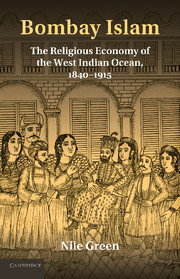Book contents
- Frontmatter
- Contents
- Illustrations
- Acknowledgements
- Maps
- Introduction
- 1 Missionaries and Reformists in the Market of Islams
- 2 Cosmopolitan Cults and the Economy of Miracles
- 3 The Enchantment of Industrial Communications
- 4 Exports for an Iranian Marketplace
- 5 The Making of a Neo-Ismā‘īlism
- 6 A Theology for the Mills and Dockyards
- 7 Bombay Islam in the Ocean's Southern City
- Conclusions
- Notes
- Bibliography
- Index
4 - Exports for an Iranian Marketplace
Published online by Cambridge University Press: 03 May 2011
- Frontmatter
- Contents
- Illustrations
- Acknowledgements
- Maps
- Introduction
- 1 Missionaries and Reformists in the Market of Islams
- 2 Cosmopolitan Cults and the Economy of Miracles
- 3 The Enchantment of Industrial Communications
- 4 Exports for an Iranian Marketplace
- 5 The Making of a Neo-Ismā‘īlism
- 6 A Theology for the Mills and Dockyards
- 7 Bombay Islam in the Ocean's Southern City
- Conclusions
- Notes
- Bibliography
- Index
Summary
BOMBAY AND THE RELIGIOUS ECONOMY OF IRAN
The migration of Iranians to India forms one of the great themes in the religious history of both India and Iran. But while these interchanges are common enough knowledge with regard to the pre-modern period, their continuity – and, indeed, acceleration – through the nineteenth century has been neglected. From the early nineteenth century, India was key to the development of Iran's diplomatic contacts with the wider world and Iranian relations with Britain were brokered through the exchange of ambassadors with Calcutta as much as London. In the opening years of the nineteenth century, the ill-fated voyage to India of the resident of Bushire, Hājjī Muhammad Khalīl, on behalf of the Iranian ruler Fath ‘Alī Shāh began this round of diplomatic exchanges with India, and soon led to the establishment of a permanent Iranian consul in Bombay. These diplomatic relations, and the founding of the consulate in Bombay, were a reflection of the expansion of trade between the two regions. We must look first, then, at the trade connections that underwrote Bombay's connections with Iran. Recent scholarship has begun to draw attention to the persistency of mercantile connections between Indian and Iranian merchants in the nineteenth century. The old Iranian trading town of Kerman, for example, maintained a growing population of Indian merchants throughout the century, while the renewed ties between the Zoroastrians of Yazd and their Parsi co-religionists in Bombay assured the presence of a wealthy contingent of Indian merchants in Yazd as well.
- Type
- Chapter
- Information
- Bombay IslamThe Religious Economy of the West Indian Ocean, 1840–1915, pp. 118 - 154Publisher: Cambridge University PressPrint publication year: 2011
- 1
- Cited by



